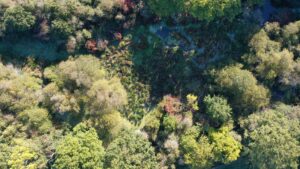
Knepp’s 2025 in numbers
knepp’s 2025 in numbers 2025 has been quite a year. Our butterfly summer was record-breaking, we re-launched the Knepp Wilding Podcast with Isabella Tree as
Home / February: Habitat stacks and wilder veg

Moy Fierheller | Deputy Head Gardener
Published March 2025
The garden is in muted shades of rust and olive, khaki and off-white, shadows of yew-green. The early weeks are crisp, sun-filled winter days, bookended with drab wet spells while we battle the castle roses and vines that clothe the walls from the heights of a cherry picker. We’re steadily working our way through the Walled Garden’s climbing roses- unlike the more formal training we employ around the house, we browse the sweet tips of the lower stems like the cutting teeth of the Exmoor ponies on the estate and leave the higher tangles with hips intact for songbirds, spiny safe-havens for nesting.
Among the sand and crushed concrete slopes and hollows of the Rewilded Garden the planting is in transition. The perennials and grasses are in gradual states of decline and decay, small empires falling before new eras arise. Occasional pockets of deep midnight-blue snow iris (Iris reticulata), the demure, bowed heads of vivid maroon Lenten roses (Helleborus orientalis) and butter-yellow narcissi are like mini-explosions among the blackening die-back. We begin to graze and trample, the fall and clear sporadic and random. We’re reflecting the vagaries of the free-roaming herbivores in the rewilding project where a matriarch long horn cow might lead the herd to new shoots on a wild rose or honeysuckle. An older buck browsing a hedge line with a bachelor herd of fallow deer teens. The size and plenitude of vegetation dictates the disturbance and fertilisation of the ground beneath, and this haphazard landscape engineering creates the mosaic landscape of diverse habitats we try to mimic.
But we are mindful too that we work in a space that is a human construct, trying to stretch and expand the ideas of beauty, to merge the seeming chaos (some might say ‘messiness’) of nature and a sense of order – that humans have walked through this landscape. In a natural setting much of the detritus of winter will disappear; break down into compost as insects, rain and frost dictates; move with the hooves and hides of animals; become nesting material for birds and small mammals. Those clusters of dead stems and leaves left undisturbed will be dry or moist, warmer safe spaces for insects, spiders, molluscs and amphibians to find food and refuge from the season’s harsh environment.
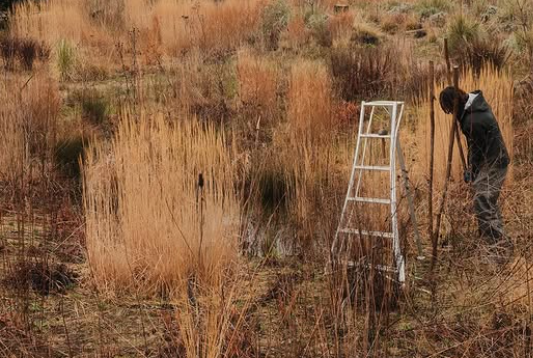
We are always experimenting with how to assemble these natural processes in a way that makes the garden more ‘readable’ to the human eye. In the bowl of the ephemeral pond, the emerald green tips of the large camas (Camassia leichtlinii ‘Caerulea’) are just beginning to push the sandy soil aside, and the once upright purple moor grass, Chinese silver grass and switch grass (Molinia caerulea ‘Edith Dudszus’, Miscanthus sinensis ‘Ferner Osten’ and Panicum virgatum ‘Shenandoah’) are strewn and laying vertical, haphazard as a game of pick-up-sticks. This is a young garden, only planted four years ago, and the 3D structural complexity we find in the rewilding project that attracts and supports wildlife will take some years to achieve. We choose to build some taller and larger structures than some of our previous creations, both to gather the fallen grass stems as habitat, keeping them within the landscape and provide a mid-level layer.
Two-and-a-half-metre stout hazel poles driven into the sand formed the scaffolding, with some crossed struts in the centre to strengthen the build and allow for air pockets between bundles of material. Slowly the stacked towers evolve to resemble a tiramisù of oyster, russet and mushroom hues. We’ll observe over the season what invertebrates might inhabit these refuges as they collapse and change over time.
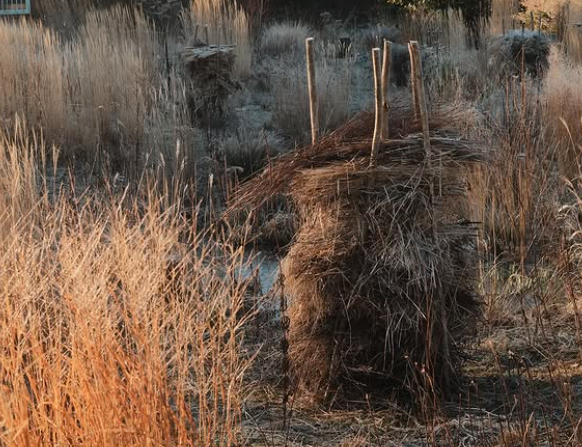
At Lewes’ Seedy Saturday, Suzi Turner, Deputy Head Gardener in charge of the Kitchen Garden’s edibles, kicks off the month delivering a talk with Rosanna Catterall, one half of the team that transformed a 3-acre pony paddock into Knepp’s thriving organic Market Garden. It’s an annual event where seeds are swapped, plants and heritage seeds can be bought, community and wildlife-focused groups busily engage in conversations and trade stories while talks and workshops pepper the day. Over a thousand people bustled through the crowded halls, and a fair few squeezed into the space to hear Suzi and Roseanna.
Entitled ‘A Wilder Way to Grow Vegetables’, they discussed the triumphs and difficulties of assimilating productivity, biodiversity and aesthetics. Although the Kitchen Garden operates on a very much smaller scale than the Market Garden, providing for the family and houseguests, the tussle to achieve the sweet spot where all three aims meet is the same. Trying to work with natural processes such as building up predator/prey relationships, keeping roots in the soil to feed the soil biota, maintaining a no-dig or light-till system, having year-round nectar sources for pollinators as well as keeping their winter habitats in mind is a juggling act. Especially in Suzi’s case, the onslaught of wildlife partial to her plantings includes voles and field mice, pigeons, slugs and snails, flea beetles, allium leaf miner, and cabbage white caterpillars. Just as in the rest of the garden, moving away from dominating the land and toward being part of a dynamic ecosystem is key. We’re aware of the privilege of not having to rely on the produce to keep hunger at bay, and there is an element of acceptance that food is for sharing, even with those uninvited guests. Promoting a healthy living soil with a complex diversity of the smallest bacteria to the largest mites, centipedes and worms is the foundation from which all else follows and thrives. Despite living in an era of one-click, fix-it answers, learning by close observation and trial and error for each unique patch of Eden, is the wisdom that Suzi and Rosanna pass on. Shifting our aesthetic desire for regimental cleanliness to a more relaxed space with underplanting, wild edges, cover cropping and habitat structures can help us to cultivate a more rewilded mindset, as well as boost biodiversity and productivity.
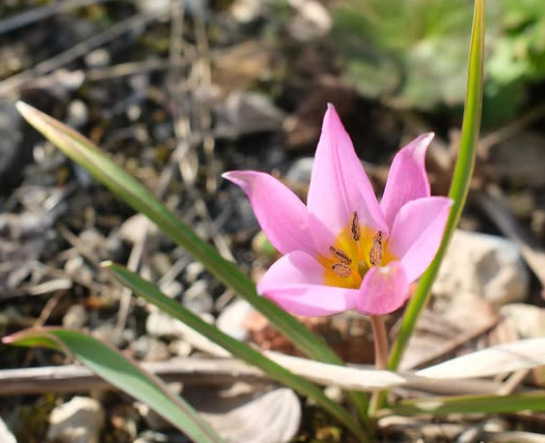
February ends with warm winds from the south and we feel the end of the tunnel is in sight. As if summoned to a party and arriving all at the same time, breathless and excitable, delicate, palest-yellow hoop petticoat daffodils (Narcissus bulbocodium ‘Arctic Bells’) unfurl amongst the purple cups of Tuscan crocus (Crocus etruscus ‘Zwanenburg’), sprinkles of bright pink teardrop-buds of low-growing Tulipa humilis and amethyst-blues of winter windflower (Anemone blanda ‘Atrocaerulea’) seem to emerge overnight.
There are more reasons to be cheerful – the government and Natural England break the news that beavers are now licensed to be introduced into the wild, a historic decision to aid river and wetland restoration and help with the UK’s flood management. The National Biodiversity Strategy and Action Plan – a blueprint for halting and reversing biodiversity loss including a legally binding target to halt biodiversity loss by 2030, was also released in the last week. We can finally see the sun still resting on the horizon just after 5pm – we’re standing on tiptoe, peeking over the rim of winter into spring and beyond
Photos courtesy of Karen Finley, Charlie Harpur
Visit the Walled Garden. Find out What’s On at Knepp including our Rewild Your Vegetable Garden and Market Garden workshops.
What we’re reading:
Seedy Saturday 2025 — Common Cause
Flies with Dr Erica McAlister – wildlife podcast | BBC Gardeners World Magazine
National Biodiversity Strategy and Action Plan | United Kingdom Biodiversity
Beaver wild release: a milestone for nature recovery in England – Natural England

knepp’s 2025 in numbers 2025 has been quite a year. Our butterfly summer was record-breaking, we re-launched the Knepp Wilding Podcast with Isabella Tree as
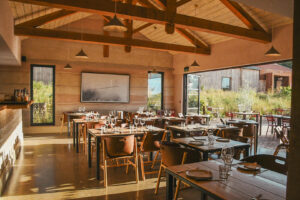
Knepp Wilding Kitchen- Restaurant Supervisor Job Description We are looking for a dynamic, enthusiastic and experienced front-of-house professional looking for a new challenge and to

Moy Fierheller | Deputy Head Gardener Published December 2025 Visit Knepp’s rewilded Walled Garden November begins with warmth and rain. The remnants of Hurricane Melissa that caused tragedy and catastrophic
Knepp Wildland Safaris, our gardens and campsite are all about the quiet and patient observation of nature.
Some of the species we are likely to encounter are shy or can be frightened by loud noises or sudden movements. Our campsite with open-air fire-pits, wood-burning stoves and an on-site pond is unsuitable for small children.
For this reason, our safaris, garden visits, holiday cottages and campsite are suitable only for children of 12 and over.
You’ll receive relevant offers and news by email. This will include information about the Rewilding Project, online store products, the Wilding Kitchen Restaurant / Cafe, and other exciting experiences / events across the Knepp Castle Estate. For more information, view our Privacy Policy.